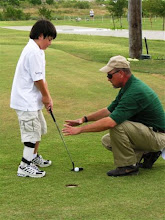Many lessons to learn from this 5 year old golfer. My favorites:
- Children, children with disabilities, know no boundaries.
- The capacity of the imitative instinct children possess.
The golfer's resource center. Custom fit/custom built golf clubs, Instruction, Adaptive clubs/lessons for disabilities, Accessories, Playing aids, How to videos/articles for clubmaking/instruction, Teaching the teacher, Mental game coaching for peak performance.
